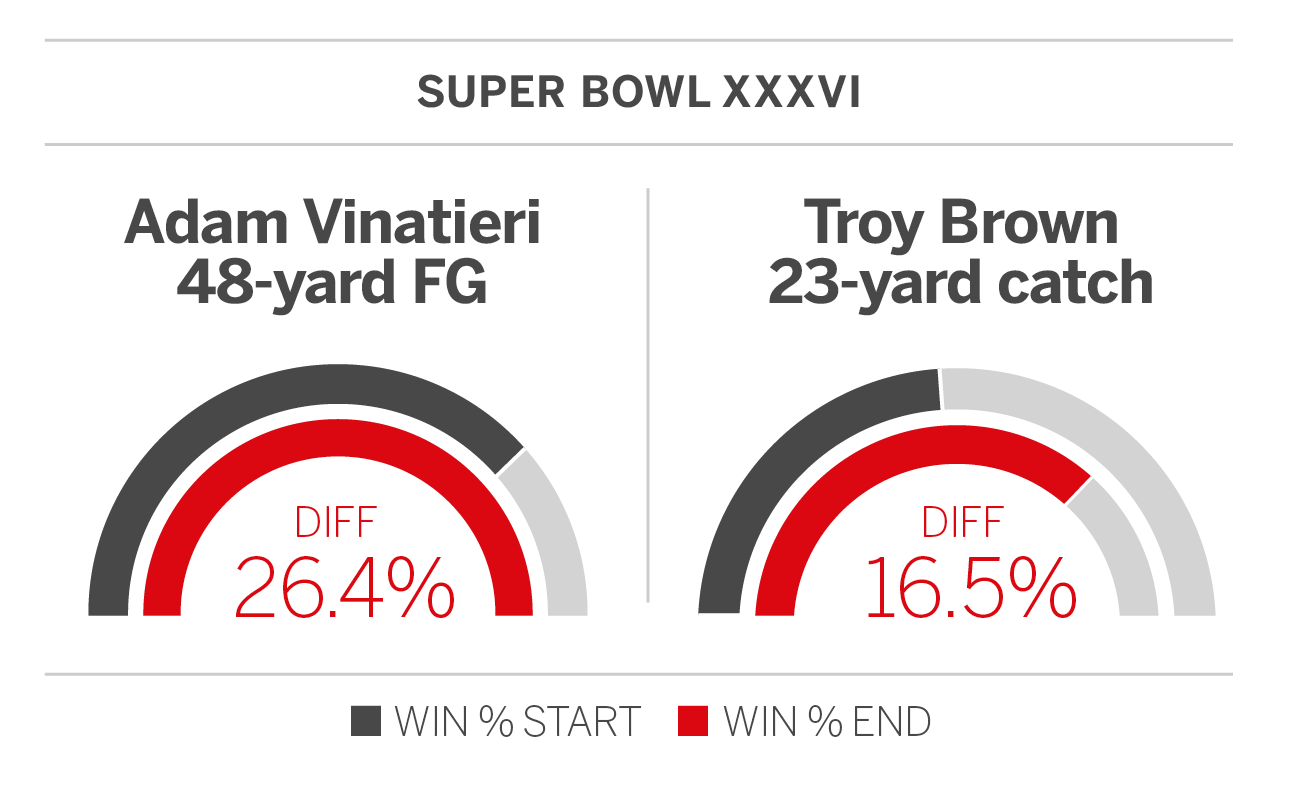The New England Patriots have by far the best record in the NFL since the start of the 2001 season, when Tom Brady ascended as starting quarterback for Bill Belichick's team. No franchise is within 30 victories of their 196-60 regular-season record.
They will play Sunday in their seventh Super Bowl over that span. Brady is going to the Pro Football Hall of Fame one day, and Belichick might well be remembered as the best football coach in history.
Yet their margin in the most important games of that span -- the six games that have sealed the history of their dynasty -- is incredibly thin. Those six Super Bowls have been decided by an average of 3.3 points, and none by more than four. Viewed objectively, the Brady/Belichick Patriots are but a few plays away from never winning a Super Bowl -- or winning all six.
This is unusual relative to the rest of Super Bowl history. Only 12 of the other 44 Super Bowls have been decided by one score. In terms of more advanced analytics, consider this: 17 of the 50 biggest single-play swings in Super Bowl win probability have occurred in games involving the Patriots since 2001. (Win probability is a statistical model that estimates, based on history, a team's chances of winning given the exact circumstances of the moment.)
As Super Bowl LI finally comes into focus after two weeks of hype, let's use win probability to identify a handful of plays that have cemented the Patriots' history. In some cases, the plays that most swung the likely outcome are different from what you might think. Win probability research is courtesy of ESPN Stats & Information senior statistics analyst Jacob Nitzberg. (Note: In each chart below, "diff" signifies the difference from the win probability at the start of the play to the end of the play, and the percentage always refers to the Patriots' win probability.)
Super Bowl XLIX, Feb. 1, 2015
Patriots 28, Seahawks 24
Play No. 1: The Patriots seemed to have their fourth title wrapped up before Seahawks receiver Jermaine Kearse's miracle 33-yard catch on the right sideline. Needing a touchdown to win, the Seahawks were suddenly in business at the Patriots' 5-yard line with 1:14 left -- a sequence that evoked memories of two other incredible catches that helped defeat them in previous Super Bowls.
Play No. 2: Second down. The Seahawks have the ball at the Patriots' 1-yard line. Only 26 seconds remain. You remember what happened next, right? Patriots cornerback Malcolm Butler intercepted Seahawks quarterback Russell Wilson's pass to prevent the go-ahead touchdown, preserve the lead and seal the victory.
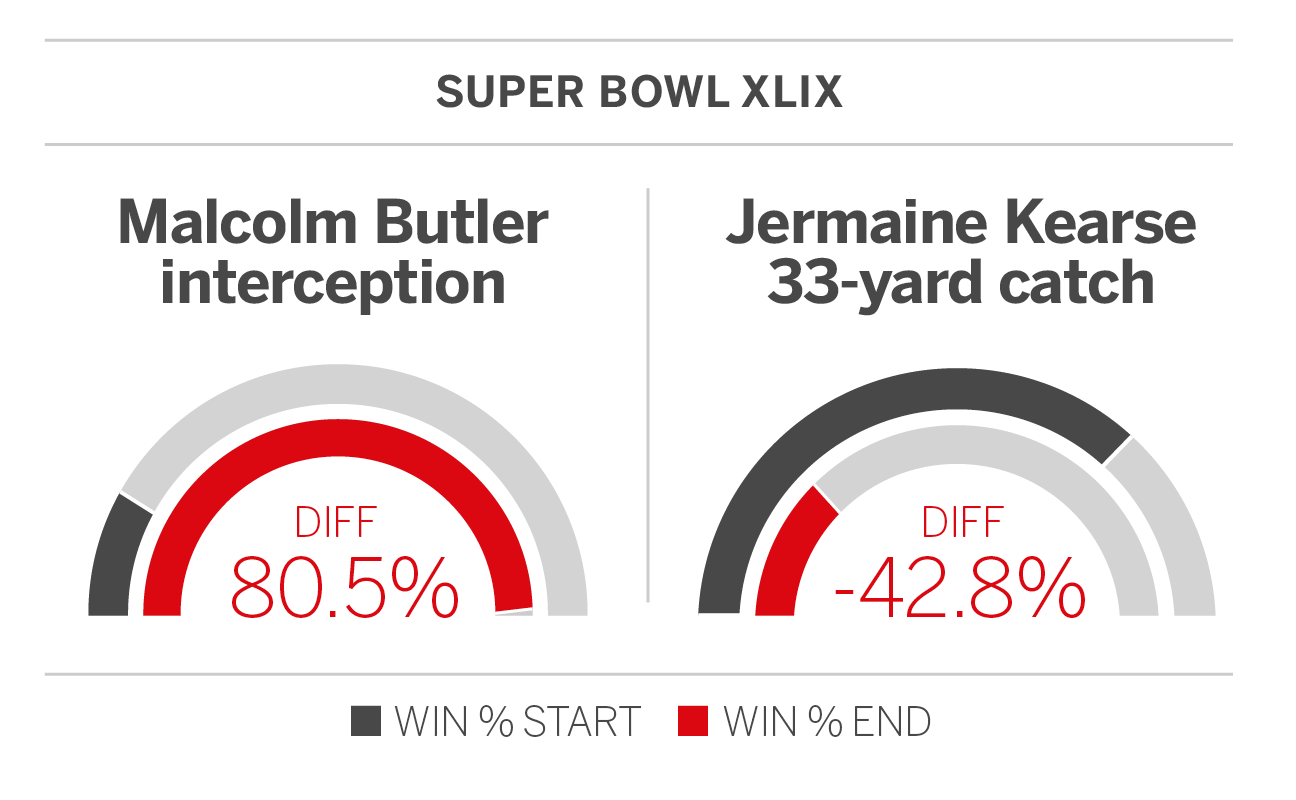
Super Bowl XLVI, Feb. 5, 2012
Giants 21, Patriots 17
Play No. 1: Although a beautiful 38-yard catch by Giants receiver Mario Manningham is etched in our memories, the Patriots were still in decent shape at that point. They held a 17-15 lead with 3:46 remaining. The ball was at midfield and their win probability remained 53.3 percent. The real killer was QB Eli Manning's 14-yard pass to receiver Hakeem Nicks, about a minute and a half later, on second down. That play put the Giants inside the Patriots' 20-yard line (at the 18), well in range of a field goal.
Play No. 2: A field goal in that situation wouldn't have been a crusher. The Patriots would have gotten the ball back needing just a field goal of their own to win. (Place-kicker Stephen Gostkowski had converted all five postseason attempts and had missed only twice since Halloween.) But with 1:04 remaining, Giants running back Ahmad Bradshaw broke through on a 6-yard touchdown run to give New York a four-point lead. Bradshaw unsuccessfully tried to give himself up before getting into the end zone, hoping to use more time, but in the end the Patriots didn't have much chance to launch a touchdown drive of their own.
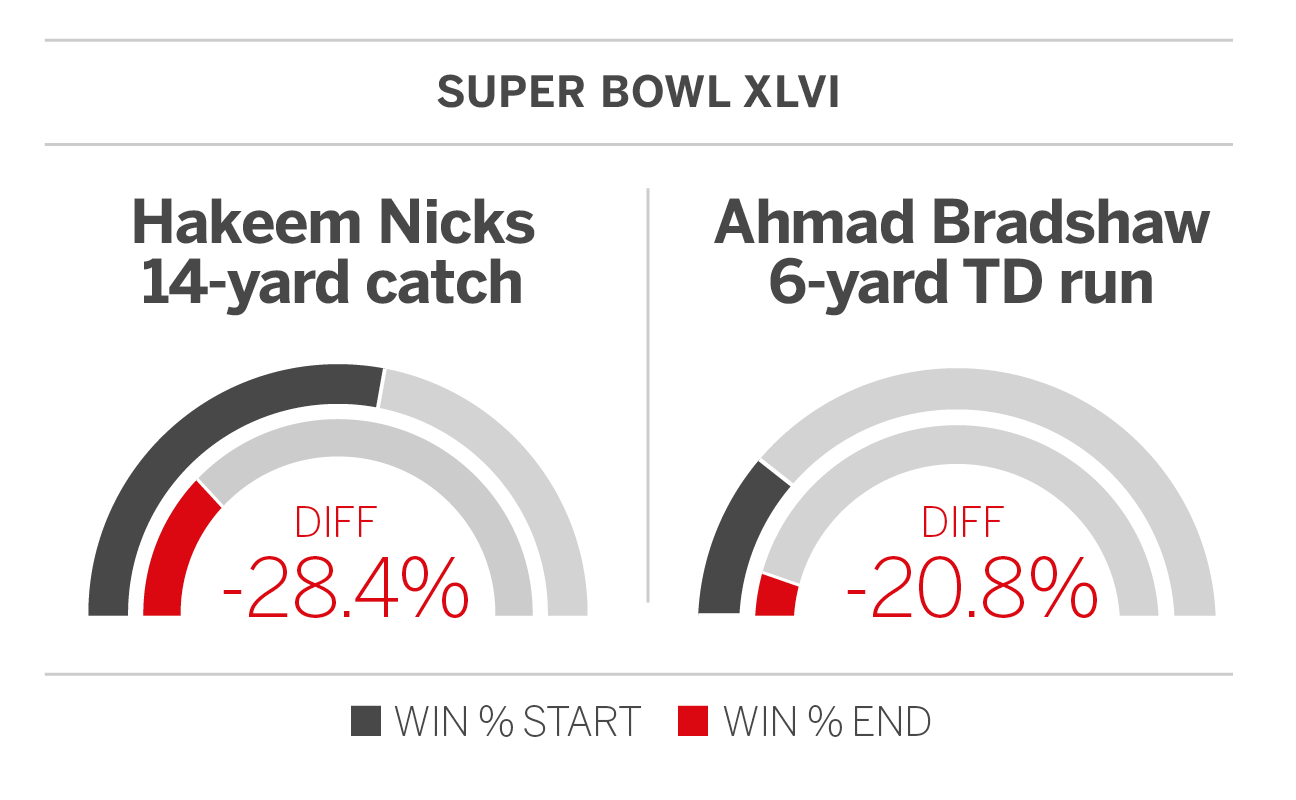
Super Bowl XLII, Feb. 3, 2008
Giants 17, Patriots 14
Play No. 1: Trailing by four points with 39 seconds remaining, the Giants had a first down at the Patriots' 13-yard line. But with no timeouts remaining, the win probability model saw their potential success as a 50-50 proposition. But Manning dropped a perfect pass to receiver Plaxico Burress for a score that left the Patriots with less than a 10 percent chance of winning.
Play No. 2: No one will forget receiver David Tyree trapping the ball on his helmet for a 32-yard reception to extend the Giants' winning drive. But it still left the Giants 24 yards away from victory as the clock ticked. The play that really put them in business, especially considering they were out of timeouts, was a 12-yard pass to receiver Steve Smith, one that converted a third-and-11 with 45 seconds left. That play set up the winning score.
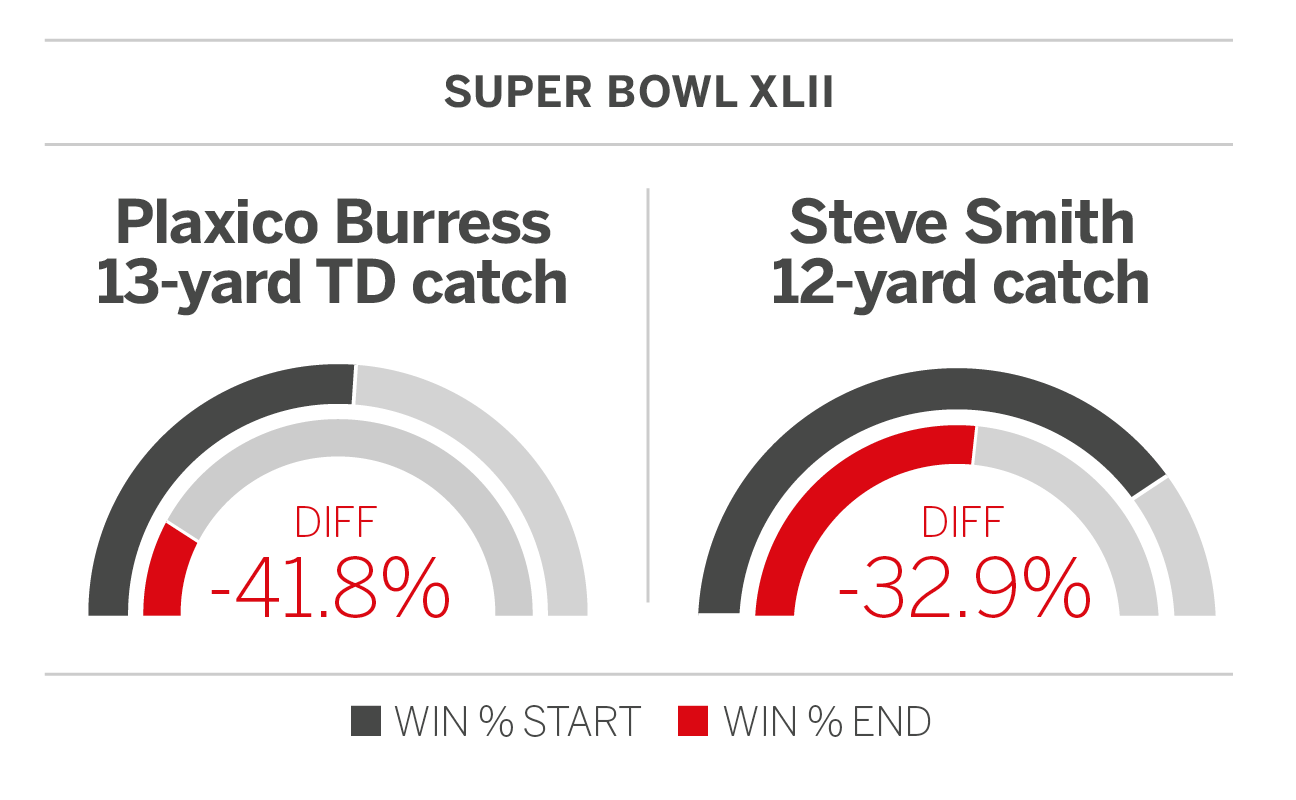
Super Bowl XXXIX, Feb. 6, 2005
Patriots 24, Eagles 21
Play No. 1: Safety Rodney Harrison intercepted a Donovan McNabb pass at the Patriots' 4-yard line to terminate an early Eagles scoring threat. True, the play occurred in the first quarter. But Harrison probably saved at least a field goal in a game that was ultimately decided by three points.
Play No. 2: Tied 7-7 early in the third quarter, the Patriots faced third-and-10 from the Eagles' 38-yard line. They were well out of comfortable field goal range. That's what made Brady's 15-yard pass to Deion Branch so important. It converted a first down and set up the Patriots' first lead of the game, a 2-yard touchdown pass to Mike Vrabel. The Patriots did not trail the rest of the game.

Super Bowl XXXVIII, Feb. 1, 2004
Patriots 32, Panthers 29
Play No. 1: The Patriots were trailing 22-21 in a wild fourth quarter when they faced third-and-9 from the Panthers' 21-yard line at the 3:40 mark. A field goal would have provided a precarious lead given the Panthers' ongoing offensive explosion, but Brady found receiver David Givens for an 18-yard gain to the Panthers' 3-yard line. Vrabel's ensuing touchdown reception put them up 29-22, and they never trailed again.
Play No. 2: The Patriots glided down the field after the Panthers tied the score, and Vinatieri's 41-yard field goal with 4 seconds left clinched it. He had missed only one field goal all season, but the NFL average conversion rate from 41 yards that season was a relatively low 71.4 percent.
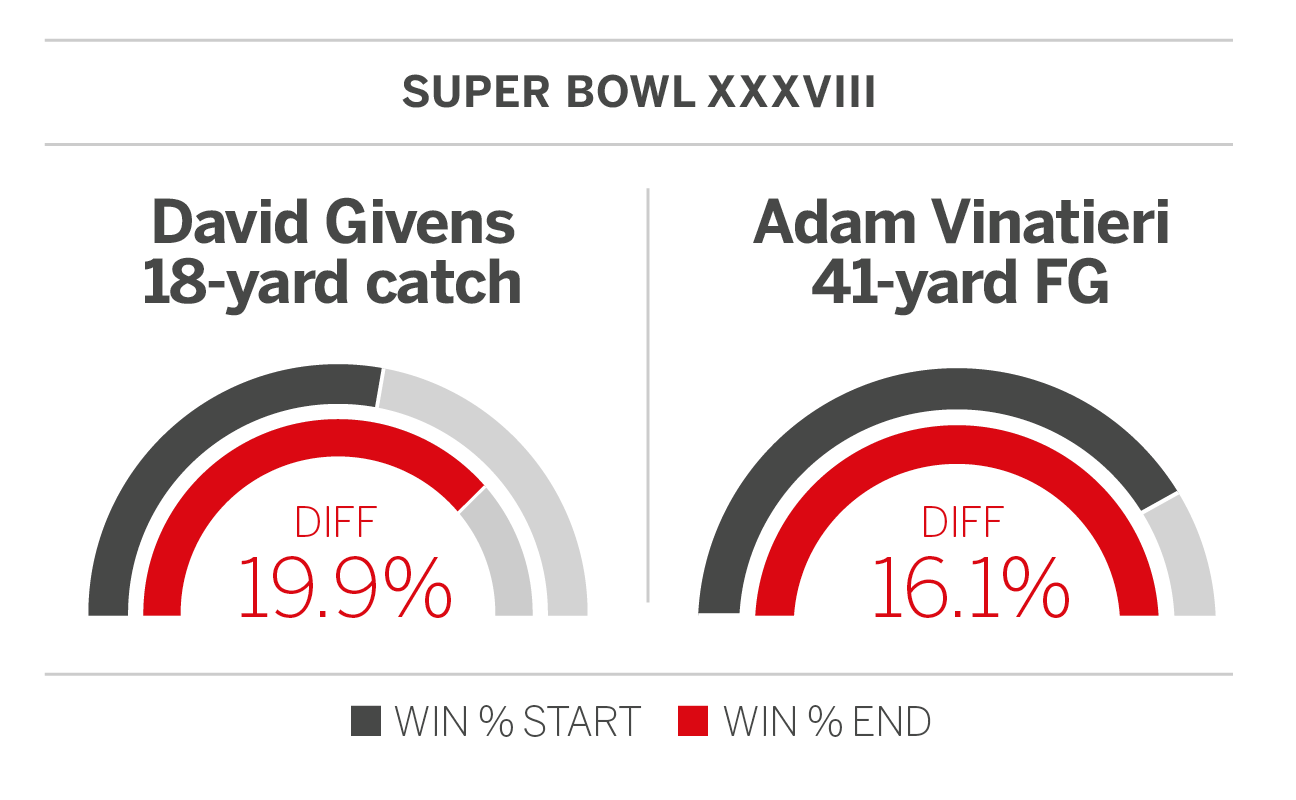
Super Bowl XXXVI, Feb. 3, 2002
Patriots 20, Rams 17
Play No. 1: Vinatieri's 48-yard field goal with no time left started the Patriots' dynasty. Keep in mind that in 2001, NFL place-kickers converted 46.8 percent of 48-yard attempts. Vinatieri had converted only 58.3 percent of attempts between 40 and 49 yards. The win probability model accounted for the indoor environment of the Superdome, and at the worst the Patriots were going to overtime with the Rams. But in those days, it was a relatively low-percentage attempt.
Play No. 2: The drive that led to Vinatieri's kick included so many memorable plays, but the Patriots' win probability swung most dramatically after Brady's 23-yard pass to Troy Brown. The play put the ball at the Rams' 36-yard line, nearly in Vinatieri's range, with 29 seconds remaining. It was the first time during the drive when the Patriots had a better than even chance to win.
